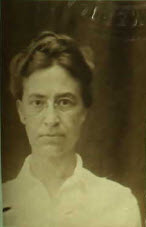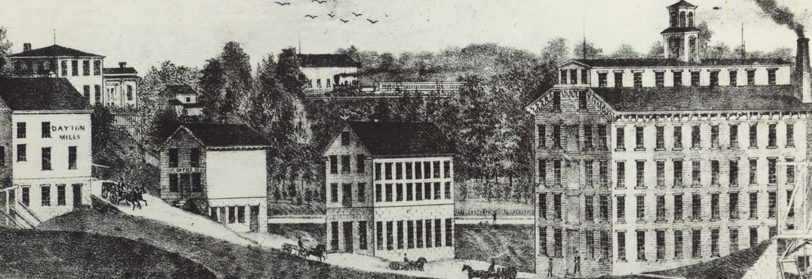
Emma May Rhoads
[When I go trawling the Internet for mention of Dayton people, I sometimes find rather tenuous connections. In this case, she was born in Dayton township, but the family moved to Ottawa almost immediately. However, her story was so interesting I am claiming her as a Dayton person.]
Emma May Rhoads was born in Dayton township on September 19, 1874, the daughter of Thomas Rhoads and Kathrine Bardouner. The family moved to Ottawa shortly thereafter, where Emma went to school, graduating from Ottawa Township High School in 1893.
She attended the University of Illinois in Champaign-Urbana, working on the Daily Illini, the student newspaper, and graduating in 1899. She was a member of Kappa Kappa Gamma, the Aletheni Literary Society, and was president of the Y.W.C.A. in 1898/99. It was here that she became acquainted with her future husband, Edward Nickoley.
After graduating from the U of I in 1898, Edward departed for missionary work in Beirut, Syria, at the Syrian Protestant College, later the American University of Beirut. Emma taught in New York for several years after she graduated, and on August 12, 1903, they were married in Champaign, Illinois. She returned with him to Beirut, Syria, where he was a teacher in the Commerce department. For several years she was the general secretary of the Y.W.C.A. for Syria and Palestine.

Kathrine, Emma, and Edward Nickoley
In 1914 Edward had a furlough year and Emma and their daughter, Kathrine, returned to spend the time in Urbana while he was occupied elsewhere. Emma enrolled in the University of Illinois, in the graduate school of literature, making a special study of Journalism.
The situation in Europe was becoming increasingly dangerous, and in August, Edward landed at New York in the last ship to leave Hamburg, Germany. The ship was chased by French cruisers, but escaped capture and landed safely in New York. Edward joined his wife and daughter in Urbana and enrolled at the University. In June 1915, both received master’s degrees: Edward in economics and Emma in English.
They had planned to return to Beirut in September, 1915, but owing to the war conditions existing in the East, they were unable to. They stayed in Urbana and registered in the Graduate School again, pending the bettering of war conditions and the assurance of reasonable safety on the seas in the return trip to the college at Beirut.
By January, it appeared possible to make the attempt to return to Syria. They left New York on January 24 on the Greek liner Vasilef Constantinos. French, English and German ambassadors gave every assurance that the passage of the neutral liner would be safe. They planned to remain in Athens for a week for the purpose of visiting the ruins and the other points of interest about the city. From Athens , they would go on the U. S. man-of-war Des Moines to Beirut in Syria.
They had plenty of time to sightsee, as they were still in Athens in April, awaiting special passports from the French to allow them to pass the blockade into Syria. By fall they still had not been able to get to their destination. In October, Emma and Kathrine returned to Urbana, where she gave the following interview:
We left for Athens last January, where we expected to go on board the U. S. gunboat Des Moines for Beirut, but the Turkish government absolutely forbade our landing at any ports on the Mediterranean. So we spent the next nine months in Greece in the hopes of finding some means by which we might get into Beirut. Finally, my husband was ordered to make the trip overland, which he is now attempting to do. Although it is only a two days trip by water, the journey overland involves going through France, Switzerland, Austria, Constantinople and lastly a long trip across country to Beirut, which will take at least three weeks. According to newspaper accounts, however, it will be impossible to get into Austria at all, in which case he will return home at once. I do not think that my daughter and I will be able to return to Syria until the war is over.
Edward did succeed in his overland trip, but Emma was correct that it would be some time before she and Kathrine could return. She again enrolled in the university, studying library science. It was not until February 1919 that Emma and Kathrine sailed from New York for Beirut, with a unit of missionaries and relief workers. They arrived in April, after being held at Port Said several weeks awaiting the arrival of a coastwise steamer.
At this time, Edward was dean of the School of Commerce and professor of economics at the American University at Beirut. From 1920 to 1923 he served as acting president, in the absence of the president. Emma did relief work in Beirut and assisted in reorganizing the University library, and daughter Kathrine taught in the home economics department. In 1923 Edward had another sabbatical leave and they returned to Illinois, to study library science (Emma) and economics (Edward). They planned that after his retirement they would return to Urbana to live.
Sadly, this was not to happen, as Edward died in 1937 in Beirut. Emma, who was then dean of women at the university, and her daughter, who taught at the school, returned to Urbana and were much in demand as speakers, telling of their experiences in Syria. As reported in the Belvidere, Illinois, Daily Republican, Emma gave a lecture to schoolchildren in Belvidere in which she told of archeologists she met while in Syria:
History students of Belvidere high school heard interesting anecdotes about archeology from Mrs. Edward Nickoley, former resident of Beirut, Syria, who gave a classroom lecture at 2 p.m yesterday in the high school.
Mrs. Nickoley explained the work of noted archeologists who she had met in Syria during her 34-year-residence at the Beirut college where her husband was professor. She described the work of James Henry Breasted of Rockford, who is considered one of the most outstanding men in his field.
Other archeologists included in Mrs. Nickoley’s talk included Lord and Lady Petrie, famous British scientists; Gertrude Bell, T. E. Lawrence, who is the author of “The Seven Pillars of Wisdom,” and Leonard Wooley.
Mrs. Nickoley knew these scientists personally. Lady Petrie gave her a priceless vase that is 2,000 years old. Mrs. Nickoley displayed the vase and other archeological specimens.
Sometime between 1958 and 1966, Emma moved from Urbana to Minnesota. She died in Rochester, Minnesota, in January, 1972, at the age of 97.





